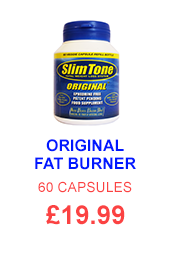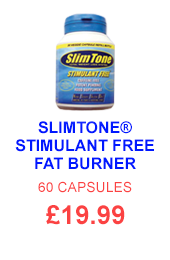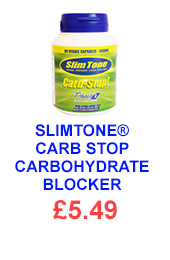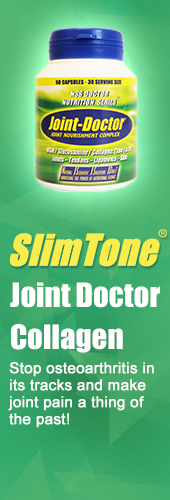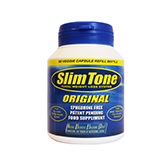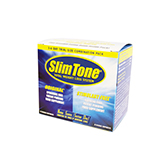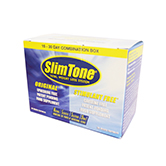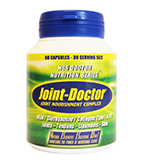 |
|
| STOP OSTEOARTHRITIS IN ITS TRACKS AND MAKE JOINT PAIN A THING OF THE PAST! |
|
JOINT DOCTOR SCIENTIFIC RESEARCH
|
Nutrition and Joint Health
![]()
Osteoarthritis is a progressive, degenerative joint disease characterised by a breakdown of the joint's cartilage (tough, flexible connective tissue), causing bones to rub against one another, which may lead to loss of movement and pain. Degenerative joint diseases have many causes including normal wear and tear of the cartilage with age, overweight or obesity, acute or chronic stress to the cartilage, joint abnormalities or misaligned joints and infectious or neuropathological changes.
A focus on weight management and the nutrients beneficial to joint health may help in the fight against joint diseases. The United States may be particularly vulnerable to joint trauma from overweight and/or obesity, since 64% of all American adults are either overweight or obese, with numbers expected to rise dramatically within the next decade. In addition, physiology of the body's joints shows that obtaining a balanced diet that contains dietary protein, vitamins C and D, and minerals, calcium and phosphorus can contribute to normal development of the cartilage and joint tissues required for healthy movement.
Though additional clinical research is necessary to identify efficacy of various dietary supplements, accumulating research on beneficial nutrients and their association with joint health brings several to the forefront. One of the more promising supplemental nutrients to date is collagen hydrolysate. Collagen is the most abundant protein in the body and gives structure to tendons, cartilage tissue, bones and connective tissue; collagen hydrolysate (CH) is collagen derived from animals and is similar in composition to that found in human cartilage.
Why is collagen hydrolysate helpful for osteoarthritis?
![]()
Research suggests that CH can stimulate the synthesis of collagen, which is important for maintaining healthy joints. Steffen Oesser, PhD, of the Department of General Surgery and Thoracic Surgery, University of Kiel, Germany, provided a summary of CH findings as presented at the conference. In order to determine whether CH can, in fact, reach and affect the joint tissue, scientists at the University of Kiel studied the absorption rate and accumulation levels of collagen hydrolysate in subjects by monitoring its uptake in the body. Results indicated that upon rapid intestinal absorption of supplemental CH, subjects experienced a doubling in the quantity of the nutrient accumulated within their cartilage tissue as compared to the control group. The findings imply that CH does reach the tissue and long-lasting accumulation is possible.
The next phase of the research was to determine whether CH may positively affect the joint tissue once it has accumulated. This would require one of two actions to take place: inhibition of the degradation of the supportive joint tissue and / or stimulation of new cartilage cells to compensate for naturally degraded tissues. In a cell culture model, researchers have been able to demonstrate that the presence of CH in the culture stimulated collagen production. When compared with collagen that is naturally present in the cells, the native collagen did not lead to this stimulatory effect. The supportive joint tissues were also stimulated to reproduce when in the presence of CH, implying that CH may be able to reduce degenerative changes in the joint tissue. Dr Oesser highlighted that, "These are significant findings because we are beginning to learn that collagen hydrolysate is not only reaching the targeted joint tissue, but we are able to observe that its presence can also create a positive change in the joint."
Additionally, Hans-Konrad Selbmann, PhD, from the German University in Tuebingen, presented the findings from his review of the literature on collagen hydrolysate and its effect on joint health. Among his research, including 16 clinical studies, two within the last decade stand out as highly significant double blind, placebo controlled clinical studies. The first was a study from 1991 by Adam, et al., which compared four treatments (CH gelatine, a gelatine-glycine-calcium-fluid combination and albumin proteins) to reduce the patients' levels of pain and their need for pain medications.
The study found that all three of the gelatine treatments were effective and significantly superior to the protein supplementation.
Where can collagen hydrolysate be found? How much is recommended?
![]()
Collagen hydrolysate is a special type of gelatine with particular physiological role and is produced directly from collagen. There are currently no official dietary guidelines or recommendations for quantity of collagen hydrolysate that will benefit health. However, based on research, a benefit has been shown by taking 10gms of collagen hydrolysate for at least three months. Because of the constant break down and regeneration of collagen, research shows that if people stop taking collagen hydrolysate altogether, the symptoms may reoccur.
Collagen hydrolysate may benefit those at risk of degenerative joint disease, and particularly osteoarthritis. Such at-risk populations include older individuals, especially those over the age of 50; individuals who are overweight; individuals whose occupational activities predispose them to osteoarthritis, including athletes and those involved in mechanical stress on cartilage.
The Osteoarthritis Research Society International (OARSI) organises the 2003 World Congress in Osteoarthritis.
Impact of Collagen Fragments on the Extra cellular Matrix Metabolism
![]()
Steffen Oesser, PhD
Surgical Research
Department of General Surgery and Thoracic Surgery
University of Kiel, Germany
Consensus exists that the therapeutic goal of causal treatment of osteoarthritis can only occur by targeting chondrocytes metabolism to counteract the catabolic processes taking place in the joint cartilage. In principle, two therapeutic concepts are conceivable: inhibiting the degradation of the structural macromolecules in the extra-cellular matrix (ECM) or stimulating the biosynthesis of cartilage cells to compensate for pathologically caused degradation of the ECM.
Experimental investigations have demonstrated intestinal absorption of collagen hydrolysate (CH) in its high molecular form with peptides up to 10kDa as well as a preferential accumulation of these CH derived fragments in cartilage tissue (Oesser et al. 1999).
In recent studies the influence of CH on the metabolism of mature chondrocytes has been investigated in a primary cell culture model (Oesser and Seifert 2003). It was shown that the presence of CH in the culture medium led to a dose-dependent increase in type II collagen biosynthesis, whereas native collagen as well as collagen-free hydrolysate failed to stimulate the production of type II collagen in chondrocytes. These results clearly indicate a stimulatory effect of CH on the type II collagen biosynthesis of chondrocytes and suggest a possible mechanism for the regulation of collagen turnover in cartilage tissue.
Moreover, utilizing immunocytochemical methods, it was demonstrated that in addition to an enhanced synthesis of type II collagen in chondrocytes treated with CH, the amount of pericellular aggrecan was significantly increased as well, indicating that the stimulated cells synthesise a complete extra cellular matrix.
Based on these results CH might be of particular importance for the nutrition of cartilage tissue and might help to reduce degenerative alterations in the ECM.
Literature
![]()
Oesser, et al. Oral administration of 14C labeled gelatine hydrolysate leads to an accumulation of radioactivity in cartilage of mice. Journal of Nutrition 1999; 129: 1891-1895.
Oesser, Seifert. Stimulation of type II collagen biosynthesis and secretion in bovine chondrocytes cultured with degraded collagen. Cell & Tissue Research 2003; 311:393-399.
Speaker Biography
Steffen Oesser, PhD
Surgical Research
Department of General Surgery and Thoracic Surgery
University of Kiel, Germany
Steffen Oesser studied biology and chemistry at the University of Kiel in Germany. As a Scientific Assistant at the Institute for Physiology of the University of Kiel, he initially concentrated on the areas of cell physiology and protein chemistry. Since 1993, Dr Oesser has been active in medical research at the Schleswig-Holstein Hospital. Subsequent to his doctoral theses on the influencing of chondrocytes metabolism, he has been principally involved in researching the pathophysiology of osteoarthritis and the development of new therapy possibilities for the treatment of degenerative disease of joint cartilage.
Nutritional Intervention for Joint Health
![]()
Berlin, Germany 17th October 2003
There are nearly 70 million people in the United States affected by arthritis and related joint health conditions. Health experts estimate that there will be a dramatic increase in the prevalence of joint disease over the next 20 years as the population of Americans living beyond their 70s is expected to double. Degenerative joint diseases, such as osteoarthritis (OA), have many causes but there are currently no cures, only palliative treatments to reduce pain and disability. It is therefore prudent to examine promising and relatively inexpensive interventions - including nutrients and proteins such as collagen hydrolysate - that may help slow down the onset of disease, improve symptoms and delay disease progression.
To recognise the advances in nutrition research (and OA) and discuss its relevance, health care professionals specializing in joint health gathered at an educational session titled, "Role of Collagen Hydrolysate in Cartilage Metabolism and Regeneration" at the eighth annual World Congress on Osteoarthritis held in Berlin, Germany. To recognise the advances in nutrition research (and OA) and discuss its relevance, health care professionals specialising in joint health gathered at an educational session titled, "Role of Collagen Hydrolysate in Cartilage Metabolism and Regeneration" at the eighth annual World Congress Osteoarthritis held in Berlin, Germany.
The Role of Nutrition in Joint Health
![]()
Kristine Clark, PhD, RD, FACSM
Director of Sports Nutrition, Penn State Orthopaedics
The Pennsylvania State University
Osteoarthritis (OA) is a progressive, degenerative joint disease characterized by a breakdown of the joint's cartilage, causing bones to rub against one another, which may lead to loos of movement and pain.
Degenerative joint diseases have many causes including normal wear and tear of the cartilage with age, overweight or obesity, acute or chronic stress to the cartilage, joint abnormalities or mal-aligned joints and infectious or neuropathlogical changes. OA affects nearly 21 million Americans. It is the most common type of arthritis; almost all individuals show signs of mile OA by the time they reach age 70. Currently, there is no medical cure for OA, only treatments to alleviate pain and symptoms. Accumulating evidence indicates that promising preventative measures such as nutrition may help slow down the onset of disease, improve symptoms and delay disease progression.
The diet of an individual can therefore play a critical role in the prevention of disorders that can influence joint disease. Food choices that offer optimal levels of calcium, vitamin C, protein, phosphorus, and vitamin D contribute to normal formation of the extra cellular matrix and articular cartilage required for healthy joint movement. In addition, weight management would help reduce any negative impact on the joints. In the United States alone, 64% of all adults are either overweight or obese. By the year 2008 obesity alone is predicted to reach 39% of all U.S. adults and 26% of children.
Though more clinical research is needed to determine the level of efficacy of various dietary supplements on improving measures of joint disease, research results on many have also shown promise. Ingredients such as omega-3 and omega-6 fatty acids, ginger and glucosamine with chondroitin sulphate are shown to relieve some degree of discomfort with joint stiffness, pain and inflammation. In addition, studies suggest that collagen hydrolysate, safe for use in food and gelatine supplements, may positively influence articular cartilage regeneration and support OA therapy.
Speaker Biography
Kristine Clark, PhD, RD, FACSM
Director of Sports Nutrition, Penn State Orthopaedics
The Pennsylvania State University
Dr. Kristine Clark is the Director of Sports Nutrition for Pen State University's Athletic Dept. where she counsels over 800 varsity athletes from 29 teams. In addition, she advises head coaches, team physicians, athletic trainers, strength and conditioning coaches, and athletic administration on policies regarding eating disorders, weight management, and supplement use among athletes.
While most of Dr. Clark's time is devoted to athletics, she also holds a faculty position as an assistant professor in the Department of Nutrition at Penn State teaching a course titled, "Nutrition for Exercise and Sport".
Dr. Clark was appointed to the Sports Medicine Advisory Board of the United States Olympic Committee in 1999. She began working as the nutritionist for the United States Women's Soccer Team in 1995 and continues as the Sports Nutritionist for the United States Soccer Federation, which includes all Olympic Develop Teams for female soccer players (5 age divisions). Dr. Clark advised the under 19 Women National Team and coaches as their nutritionist during the first ever World Cup event for this age group, which they won September 2002.
Dr. Clark holds a PhD in Nutrition Science from Penn State University, a MS degree in Health Education from the University of Wisconsin, and a BS degree in Nutrition and Dietetics from Viterbo College, LaCrosse, WI. Her research interests include food choices, timing of eating, athletic performance, and weight management. Currently, she is conducting a study on pre-exercise snacks and perceived benefits on running. Clark, a registered dietician, is a past president of the American Dietetic Association's practice group of Sports Nutritionists, a Fellow in and Trustee Member of the American College of Sports Medicine, and a frequent lecturer at national health, fitness and nutrition conferences throughout the United States. In addition, Clark serves as one of five spokespersons for the International Food Information Council and as such provides nutrition, exercise and fitness information to the media on a daily basis.
Suggested mechanism of collagen hydrolysate in joint function
![]()
CH essentially has the same amino acid composition as collagen in the joint cartilage thus making it a viable stimulus for collagen production and therefore cartilage regeneration.
In the spring of 2003 scientists from the German University Hospital of Kiel, for the first time, published evidence that collagen hydrolysate stimulates collagen synthesis in cartilage cells. In this study they added bovine chondrocytes - the cells responsible for generating cartilage - to a cell culture medium enriched with collagen hydrolysate. After three days a dose-dependent increase of collagen synthesis was observed and the CH treated cell cultures revealed a 2.5 fold higher increase in collagen stimulation compared to that of control cells.
This is the first time a cell culture model has shown that the presence of CH leads to an increase in cartilage formation and provides a scientific rationale for the improvements seen in clinical studies.
Treatment of osteoarthritis with collagen hydrolysate
![]()
Osteoarthritis is characterised by an imbalance between the generation and degradation of cartilage in the joint that yields to greater wearing away than production of the cartilage. Different causes for the imbalance have been cited such as the aging process, increased body weight, severe mechanical and repetitive strain or a developmental abnormality. Despite decades of research there is still no cure.
Joint degradation begins when people are in their 20s and 30s and affects most people by the age of 60. The number of people with degenerative joint and bone diseases is expected to increase because among other things, people are living longer and weighing more.
Osteoarthritis is the most common form of degenerative joint disease in the world. In the United States, it is estimated that eight million people have arthritis, osteoarthritis being the most common.
Natural prevention of osteoarthritis
![]()
Collagen hydrolysate is a nutritional supplement, which may be able to benefit people who suffer from osteoarthritis. While there are no official recommendations yet, scientific research suggests that 10gms of CH per day for at least three months has been beneficial. Research also shows that symptoms may reoccur if use of the supplement is discontinued.
Proven safety profile
![]()
As CH is free from cholesterol, saturated fatty acids and purines, it offers an ideal supplement profile. Collagen hydrolysate was awarded GRAS status (Generally Recognised As Safe) in 1999 by the U.S. Food and Drug Administration (FDA) confirmed in July this year again, which affirms its safety for long-term use in degenerative joint diseases.
Joint Health and Osteoarthritis: The Facts
![]()
Healthy Joint Function
A normal joint is where one bone moves on another. Ligaments hold the two bones together, and work like elastic bands to keep the bones in place while muscles lengthen and shorten to make the joint move.
Definition
A coating of cartilage covering the bone surface stops the bones from running directly against each other. This helps the joint to work smoothly.
The joint cavity contains fluid, which provides nutrients to the joint and cartilage.
Degenerative Joint Disease
Osteoarthritis is a progressive, degenerative joint disease characterised by a breakdown of the joint's cartilage, causing bones to rub against one another, which may lead to loss of movement and pain.
The hands and weight-bearing joints such as spine, knees and hips are most affected.
Causes
![]()
-
Wearing away of the cartilage with increasing age
-
Being overweight
-
Acute or chronic trauma to the cartilage or tissue surrounding it (e.g. repeated and significant mechanical stress)
-
Mal-aligned joints
-
Infectious, metabolic, endocrine or neuropathological changes
-
Congenital joint abnormalities
-
Genetic factors
- Disease processes that alter normal structure of the cartilage (e.g. gout)
Symptoms
![]()
-
Pain when beginning a movement ("warm-up pain")
-
Pain upon exercise
-
Restricted movement
- Feeling of tension and stiffness in the joints, particularly in the morning
-
Swollen joints
-
Tension in muscles and tendons
-
Grinding of the joints
- Increasing instability in the joint with local pain

Epidemiology
![]()
-
Osteoarthritis is the most common type of arthritis, especially among older people.
-
Almost all people by age 40 have some pathological changes in their weight bearing points.
-
By the time people reach age 70 almost all individuals show signs of mild osteoarthritis.
-
Osteoarthritis affects nearly 21 million Americans, mostly after age 45; women are more commonly affected than men.
- 80% of people with OA report some form of limitation in movement or activities.
Diagnosis
![]()
Symptoms of the disease
Joint degradation confirmed by X-ray
Osteoarthritis is currently incurable. Treatments focus on reduction of pain, inflammation and improving joint movement to delay by a variety of interventions. For example:
Treatment
![]()
-
Weight reduction
-
Rehabilitation to keep joints flexible and improve muscle strength
-
Optimisation of overall physical fitness via exercise (range of motion, postural, strengthening, stretching)
-
Non-steroidal anti-inflammatory drugs (NSAIDS)
-
Aspirin and analgesics for anti-inflammatory effect
-
Heat and ice treatment for temporary pain relief
-
Steroid injections into the joint to reduce inflammation
-
Surgical intervention to relieve pressure on joints or replace
- Natural products like Joint Doctor collagen complex
Additional Information
![]()
WHO has declared this decade (2000 - 2010) the "Bone and Joint Decade" in an effort to focus resources on addressing the epidemic of osteoarthritis and other major conditions affecting this area.
New highlights from research on gelatine - Natural prevention of osteoarthritis possible
Eberbach, Germany, 22 April 2003. Scientific studies and clinical experience from past decades have demonstrated gelatine has a protective effect on articular cartilage. For the first time cell researchers have been able to prove in a laboratory study that gelatine stimulates collagen synthesis in cartilage cells. The results from this study confirm the importance of gelatine in the prevention and treatment of degenerative arthritic disease
.
Scientists have been investigating the effect of gelatine on cartilage metabolism for many decades. In clinical studies based both in Germany and internationally, patients reported a significant reduction in pain following the intake of collagen hydrolysate, one of the types of gelatine suitable for therapeutic use. Further more, analgesics and anti-inflammatory agents were not taken as often and joint mobility increased.
Advances in collagen hydrolysate research
![]()
The physiologists Dr Oesser and Professor Seifert from The University of Kiel have been able to explain the physiological basis for these observations in their recently publicised laboratory study (Cell Tissue Res (March 2003) 311: 393-399) on freshly isolated chondrocytes from cartilage. The enrichment of the cell culture medium with collagen hydrolysate led to a significant stimulation of the synthesis of collagen in cartilage cells. In the experiment, mature bovine chondrocytes were preincubated in the basal cell medium for three days. Then the medium was replaced with a medium supplemented with collagen hydrolysate and the controls were replaced with a medium containing no collagen or a medium with collagen free protein hydrolysate and incubation was continued for eight days. The scientists measured the synthesis of collagen in the medium using immunocytochemical detection and by demonstrating the formation of istopically labelled amino acids. The results confirmed that the addition of collagen hydrolysate to the culture medium led to an up to 2.5 fold dose dependent increase in the secretion of collagen, which could not be demonstrated in the controls. The results reveal a possible mechanism for the complex regulation of collagen turnover in the joint. According to these results collagen degradation products stimulate collagen synthesis in a positive feedback mechanism and induce the formation of new cartilage tissue.
Prevention and treatment of osteoarthritis with collagen hydrolysate
![]()
The current observations made by the researchers are a further building block in the chain of evidence that specific intake of collagen hydrolysate in the daily diet makes good sense in the prevention and treatment of degenerative joint diseases such as osteoarthritis. "It is very plausible that collagen hydrolysate, when taken as a supplement to our normal diet, may activate the synthesis of collagen in cartilage. Particularly in situations in which cartilage is under massive stress the intake of collagen hydrolysate could be highly significant medically and reduce degenerative changes," concludes Dr Steffan Oesser.
The same conclusions have also been drawn by other leading researchers such as the American arthritis specialist Professor Roland Moskowitz and the Prague based rheumatologist Professor Milan Adam, who is considered to be the 'father' of collagen hydrolysate research. Professor Moskowitz and Adam also advocate the daily intake of collagen hydrolysate based on the results of their studies. Collagen hydrolysate is important as a dietary supplement particularly in patients with osteoarthritis or in people whose joints are put under heavy stress such as sportsmen/women or people who are overweight. The recommended daily dose is 5-10 grams.
Collagen hydrolysate's good safety profile - the FDA awarded collagen hydrolysate GRAS status (Generally Recognised as Safe) in 1975, - makes it particularly interesting as a long term treatment in the prevention and treatment of degenerative joint disease.



